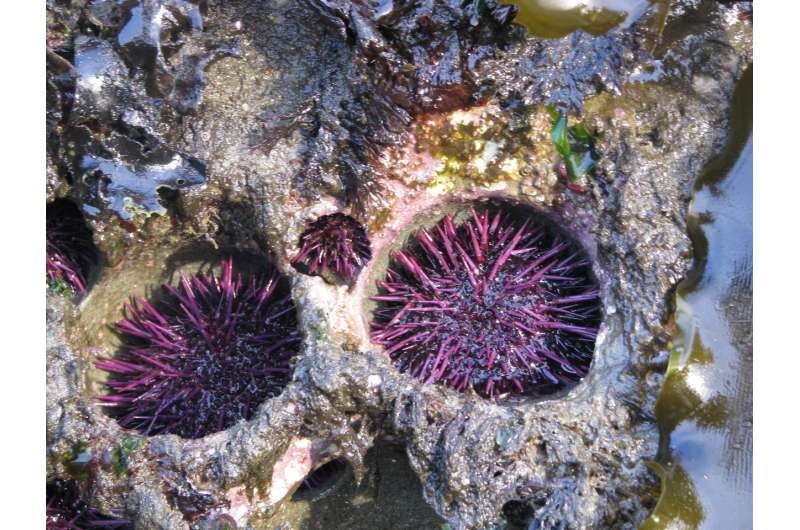Sea urchins erode rock reefs, excavate pits for themselves

Through their grazing activity, sea urchins excavate rock and form the pits they occupy. This activity may cause significant bioerosion of temperate reefs, according to a study published February 21, 2018 in the open-access journal PLOS ONE by Michael Russell from Villanova University, U.S., and colleagues.
Sea urchins live in high densities on rocky temperate reefs, and are often so snugly nestled into cavities that researchers have long wondered if they excavate these pits themselves. However, there was no experimental data to support this hypothesis or to assess its environmental consequences. The authors of the present study investigated this question by monitoring purple sea urchins, Strongylocentrotus purpuratus, on flattened rock surfaces in the lab. They used fine- and medium-grain sandstone, mudstone and granite rocks from three Californian reef sites naturally occupied by sea urchins, where the researchers also conducted field measurements.
The researchers found that sea urchins did indeed visibly sculpt the rock, removing material from all the rock surfaces during the laboratory experiment. Rates of excavation varied greatly by rock type in the lab: while each urchin excavated around 32g of medium-grain sandstone over a year, meaning that an average-sized pit could be sculpted in under five years, granite excavation was 37 times slower, so arduous that it would take more than a century to form a pit. Field measurements reflected this difference, with granite pits being shallower, and sea urchins flatter, than their sandstone counterparts.
The authors combined the laboratory rates with urchin density measurements, estimating that on medium-grain sandstone reefs, urchins might produce almost 200 tonnes of sediment per hectare per year. However, excavation rates in the field might differ significantly from laboratory rates. Nonetheless, the authors note that urchin-mediated bioerosion is a potentially important factor in temperate reef coastal erosion, and deserves further investigation.
"What shocked us was the rate of bioerosion—particularly on sandstone," says Russel. "In the course of feeding, sea urchins scrape the rock surface using their self-sharpening, regenerating teeth, which act as 'rock picks' and this process results in the excavation of pits."
More information: Russell MP, Gibbs VK, Duwan E (2018) Bioerosion by pit-forming, temperate-reef sea urchins: History, rates and broader implications. PLoS ONE 13(2): e0191278. doi.org/10.1371/journal.pone.0191278
Journal information: PLoS ONE
Provided by Public Library of Science




















